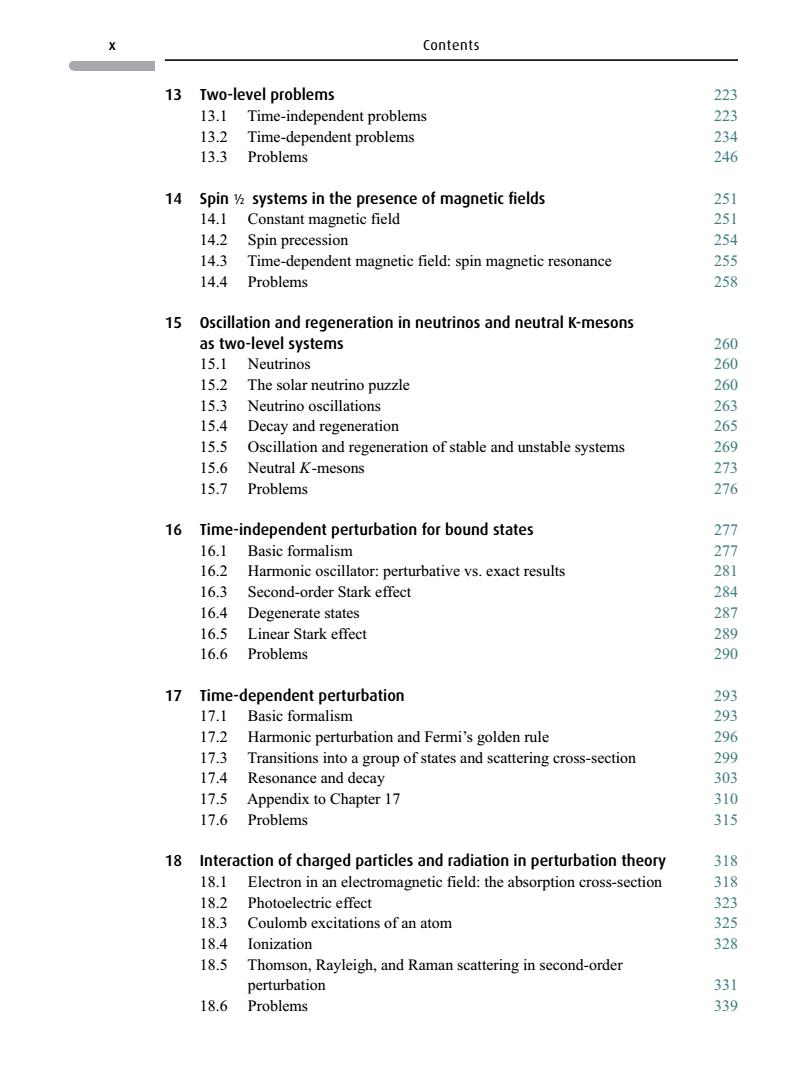
Contents 13 Two-level problems 223 13.1 Time-independent problems 223 132 Time-dependent problems 234 13.3 Problems 246 14 Spin systems in the presence of magnetic fields 141 Constant magnetic field 251 14.2 Spin precession 14.3 Time-dependent magnetic field:spin magnetic resonance 14.4 Problems 258 15 Oscillation and regeneration in neutrinos and neutral K-mesons as two-level systems 15.1 Neutrinos 260 15.2 The solar neutrino puzzle 260 Neutrino oscillations 5 Decay and regeneration 15.5 Oscillation and regeneration of stable and unstable systems 269 15.6 Neutral &-mesons 273 15.7 Problems 276 16 Time-independent perturbation for bound states 16.1 Basic formalism 277 16.2 Harm nic oscilla r:perturbative vs.exact results l63 Second-order Stark effect 16.4 Degenerate states 287 165 Linear Stark effect 289 16.6 Problems 290 17 Time-dependent perturbation 293 17.1 Basic formalism 293 17.2 Harmonic perturbation and Fermi's golden rule 17 Transitions into a group of states and scattering cross-section 286 17.4 Resonance and decav 30 17.5 Appendix to Chapter 17 310 17.6 Problems 315 18 Interaction of charged particles and radiation in perturbation theory 318 18.1 Electron in an electromagnetic field:the absorption cross-section 318 182 18.3 Coulomb excitations of an atom 184 lonization 328 18.5 Thomson.Ravleigh.and raman scattering in second-order perturbation 331 18.6 Problems 339
x Contents 13 Two-level problems 223 13.1 Time-independent problems 223 13.2 Time-dependent problems 234 13.3 Problems 246 14 Spin ½ systems in the presence of magnetic fields 251 14.1 Constant magnetic field 251 14.2 Spin precession 254 14.3 Time-dependent magnetic field: spin magnetic resonance 255 14.4 Problems 258 15 Oscillation and regeneration in neutrinos and neutral K-mesons as two-level systems 260 15.1 Neutrinos 260 15.2 The solar neutrino puzzle 260 15.3 Neutrino oscillations 263 15.4 Decay and regeneration 265 15.5 Oscillation and regeneration of stable and unstable systems 269 15.6 Neutral K-mesons 273 15.7 Problems 276 16 Time-independent perturbation for bound states 277 16.1 Basic formalism 277 16.2 Harmonic oscillator: perturbative vs. exact results 281 16.3 Second-order Stark effect 284 16.4 Degenerate states 287 16.5 Linear Stark effect 289 16.6 Problems 290 17 Time-dependent perturbation 293 17.1 Basic formalism 293 17.2 Harmonic perturbation and Fermi’s golden rule 296 17.3 Transitions into a group of states and scattering cross-section 299 17.4 Resonance and decay 303 17.5 Appendix to Chapter 17 310 17.6 Problems 315 18 Interaction of charged particles and radiation in perturbation theory 318 18.1 Electron in an electromagnetic field: the absorption cross-section 318 18.2 Photoelectric effect 323 18.3 Coulomb excitations of an atom 325 18.4 Ionization 328 18.5 Thomson, Rayleigh, and Raman scattering in second-order perturbation 331 18.6 Problems 339
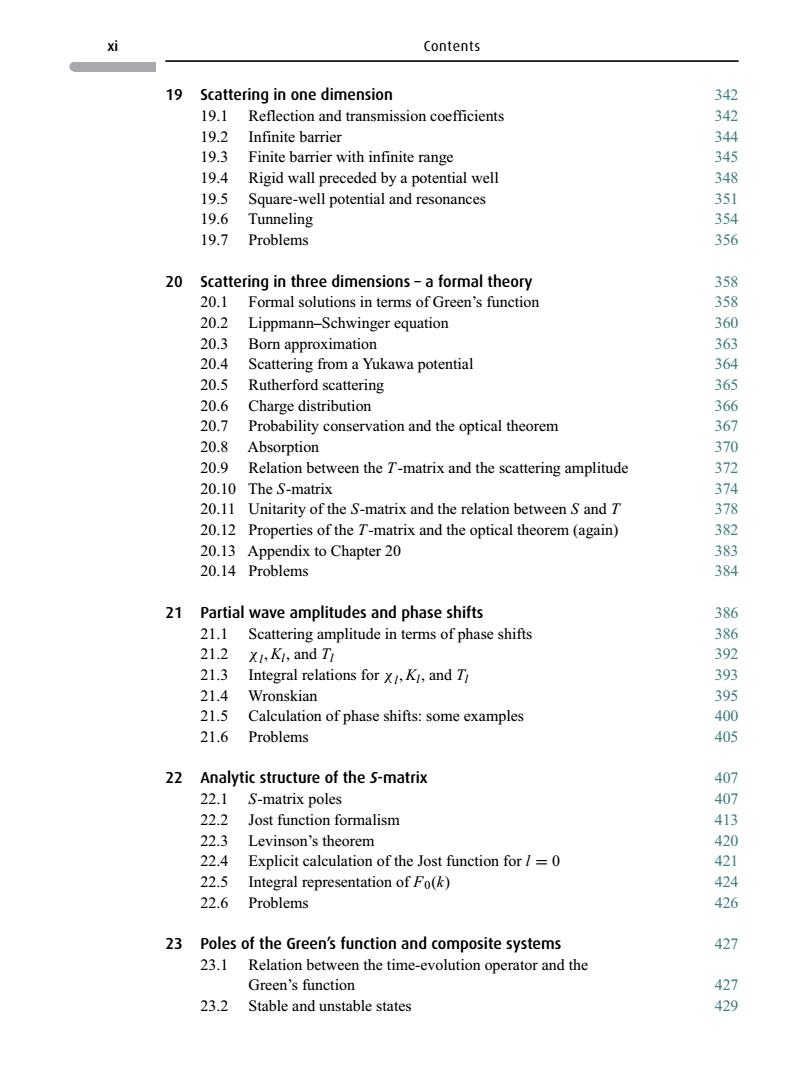
Contents 19 Scattering in one dimension 342 19.1 Reflection and transmission coefficients 19.2 Infinite barrier 19.3 Finite barrier with infinite range 345 19.4 Rigid wall preceded by a potential well 348 19.5 19.6 Square-well potential and sonances Tunneling 19.7 Problems 356 20 Scattering in three dimensions-a formal theory 20. Formal solutions in terms of Green's function 20.2 Lippmann-Schwinger equation 20.3 Born approximation 204 205 g from a Yukawa potential Rutherford scattering 20.6 Charge distribution 6 207 Probability conservation and the optical theorem 36 20.8 209 Absorption 370 Relation between the T-matrix and the scattering amplitude 20.10 The S-matrix 374 20.11 Unitarity of the S-matrix and the relation between S and T 378 20.12 Properties of the T-matrix and the optical theorem(again) 380 20.13 Appendix to Chapter 20 383 20.14 Problems 384 21 Partial wave amplitudes and phase shifts 3 21. Scattering amplitude in terms of phase shifts 386 21.2 y.Ki.and T 39 213 Integral relations for x.K.and T 393 214 Wronskian 21.5 Calculation of phase shifts:some examples 21.6 Problems 405 22 Analytic structure of the S-matrix 407 S-matrix poles 22.2 Jost function formalism 413 22.3 Levinson's theorem 420 ))4 Explicit calculation of the Jost function for/=0 421 22.5 Integral representation of Fo(k 22.6 Problems 23 Poles of the Green's function and composite systems 427 23.1 Relation between the time-evolution operator and the Green's function 427 23.2 Stable and unstable states 429
xi Contents 19 Scattering in one dimension 342 19.1 Reflection and transmission coefficients 342 19.2 Infinite barrier 344 19.3 Finite barrier with infinite range 345 19.4 Rigid wall preceded by a potential well 348 19.5 Square-well potential and resonances 351 19.6 Tunneling 354 19.7 Problems 356 20 Scattering in three dimensions–aformal theory 358 20.1 Formal solutions in terms of Green’s function 358 20.2 Lippmann–Schwinger equation 360 20.3 Born approximation 363 20.4 Scattering from a Yukawa potential 364 20.5 Rutherford scattering 365 20.6 Charge distribution 366 20.7 Probability conservation and the optical theorem 367 20.8 Absorption 370 20.9 Relation between the T-matrix and the scattering amplitude 372 20.10 The S-matrix 374 20.11 Unitarity of the S-matrix and the relation between S and T 378 20.12 Properties of the T-matrix and the optical theorem (again) 382 20.13 Appendix to Chapter 20 383 20.14 Problems 384 21 Partial wave amplitudes and phase shifts 386 21.1 Scattering amplitude in terms of phase shifts 386 21.2 χl, Kl, and Tl 392 21.3 Integral relations for χl, Kl, and Tl 393 21.4 Wronskian 395 21.5 Calculation of phase shifts: some examples 400 21.6 Problems 405 22 Analytic structure of the S-matrix 407 22.1 S-matrix poles 407 22.2 Jost function formalism 413 22.3 Levinson’s theorem 420 22.4 Explicit calculation of the Jost function for l = 0 421 22.5 Integral representation of F0(k) 424 22.6 Problems 426 23 Poles of the Green’s function and composite systems 427 23.1 Relation between the time-evolution operator and the Green’s function 427 23.2 Stable and unstable states 429
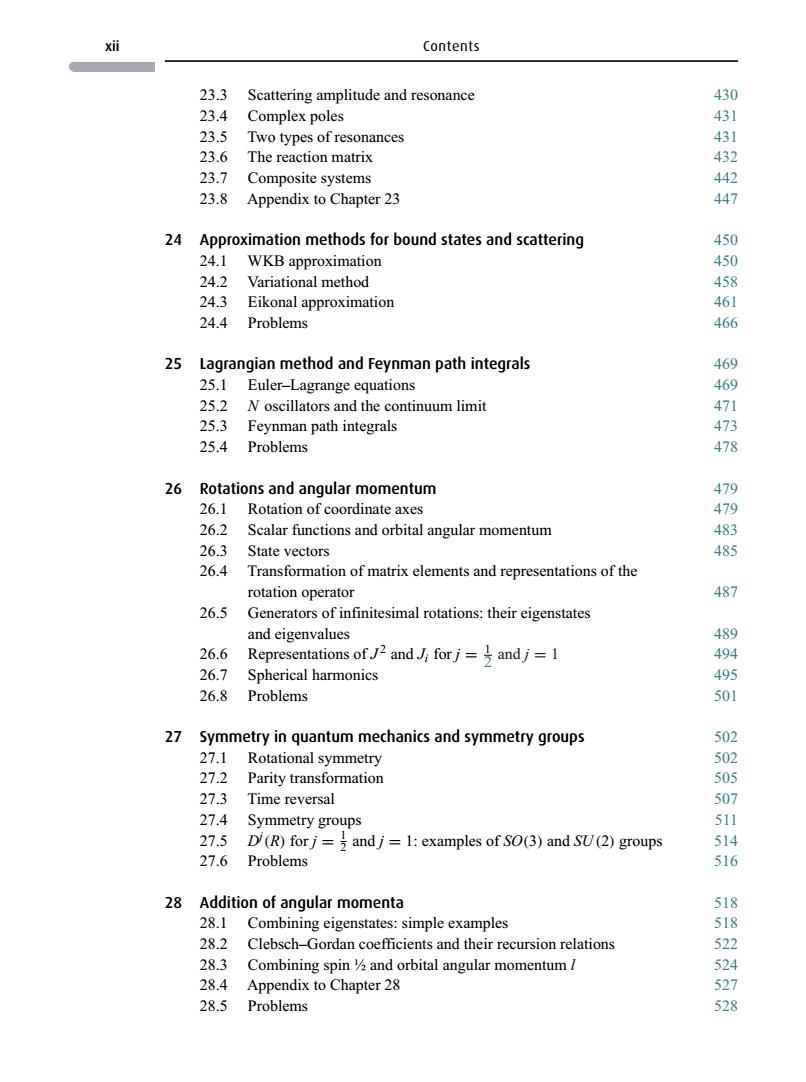
Contents 23.3 Scattering amplitude and resonance 430 23.4 Complex poles 431 235 Two types of resonances 431 The reaction matrix Composite systems 238 Appendix to Chapter 23 447 24 Approximation methods for bound states and scattering 24.1 WKB approximation 58 24.2 Variational method 458 24.3 Eikonal approximation 461 24.4 Problems 466 25 Lagrangian method and Feynman path integrals 25.1 Euler-Lagrange equations 469 N oscillators and the continuum limit Feynman path integrals 25.4 Problems 478 26 Rotations and angular momentum 479 26.1 Rotation of coordinate axes 479 26.2 Scalar functions and orbital angular momentum 483 26.3 State vectors 485 26.4 Transformation of matrix elements a and representations of the rotation operator 487 26.5 Generators of infinitesimal rotations:their eigenstates and eigenvalues 26.6 Repres tions of J2 and J for j=andj=1 26.7 Spherical harmonics 26.8 Problems 501 27 Symmetry in quantum mechanics and symmetry groups 27.1 Rotational symmetry 27.2 Parity transformation 505 27.3 Time reversal 507 27.4 Symmetry groups 27.5 D/(R)forj=and j=1:examples of SO(3)and SU(2)groups 514 27.6 Problems 516 28 Addition of angular momenta 28.1 Combining eigenstates:simple examples 28.2 Clebsch-Gordan coefficients and their recursion relations 522 28.3 Combining spin %and orbital angular momentum 524 28.4 Appendix to Chapter 28 527 28.5 Problems 528
xii Contents 23.3 Scattering amplitude and resonance 430 23.4 Complex poles 431 23.5 Two types of resonances 431 23.6 The reaction matrix 432 23.7 Composite systems 442 23.8 Appendix to Chapter 23 447 24 Approximation methods for bound states and scattering 450 24.1 WKB approximation 450 24.2 Variational method 458 24.3 Eikonal approximation 461 24.4 Problems 466 25 Lagrangian method and Feynman path integrals 469 25.1 Euler–Lagrange equations 469 25.2 N oscillators and the continuum limit 471 25.3 Feynman path integrals 473 25.4 Problems 478 26 Rotations and angular momentum 479 26.1 Rotation of coordinate axes 479 26.2 Scalar functions and orbital angular momentum 483 26.3 State vectors 485 26.4 Transformation of matrix elements and representations of the rotation operator 487 26.5 Generators of infinitesimal rotations: their eigenstates and eigenvalues 489 26.6 Representations of J 2 and Ji for j = 1 2 and j = 1 494 26.7 Spherical harmonics 495 26.8 Problems 501 27 Symmetry in quantum mechanics and symmetry groups 502 27.1 Rotational symmetry 502 27.2 Parity transformation 505 27.3 Time reversal 507 27.4 Symmetry groups 511 27.5 Dj (R) for j = 1 2 and j = 1: examples of SO(3) and SU(2) groups 514 27.6 Problems 516 28 Addition of angular momenta 518 28.1 Combining eigenstates: simple examples 518 28.2 Clebsch–Gordan coefficients and their recursion relations 522 28.3 Combining spin ½ and orbital angular momentum l 524 28.4 Appendix to Chapter 28 527 28.5 Problems 528
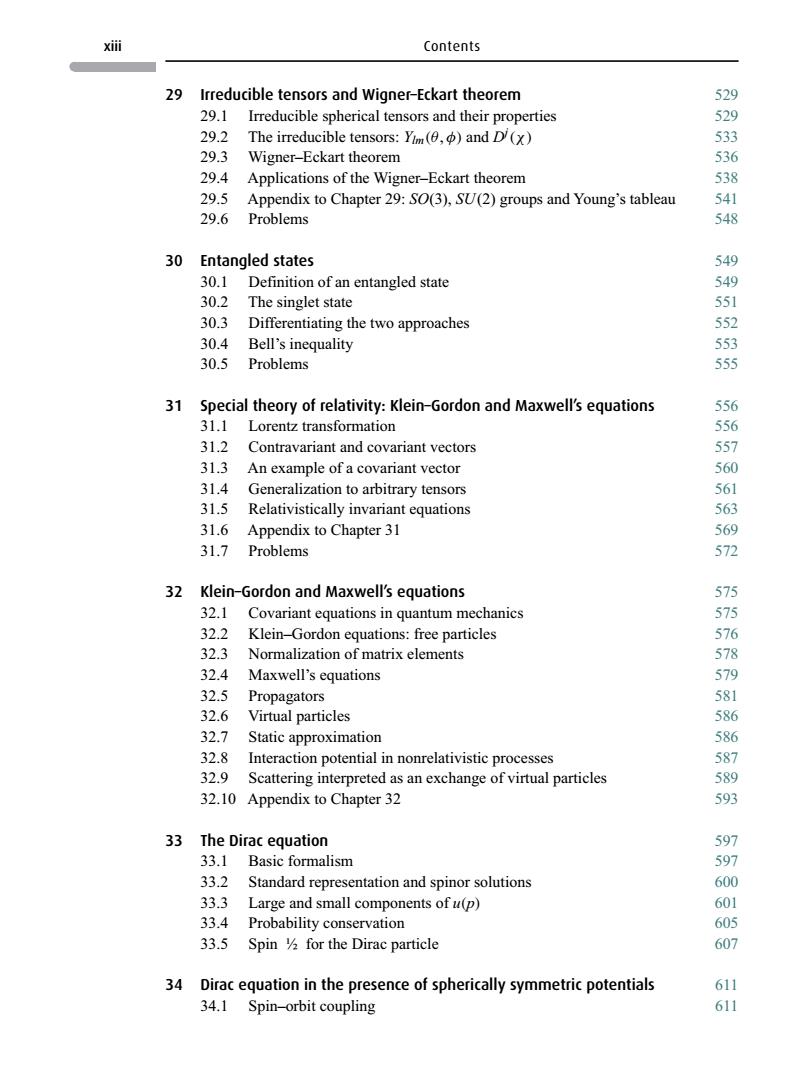
Xiii Contents 29 Irreducible tensors and Wigner-Eckart theorem 529 29.1 Irreducible spherical tensors and their properties 529 29.2 The irreducible tensors:Yim(,and D/(x) 533 29.3 Wigner-Eckart theorem 536 29.4 Applications of the Wigner-Eckart theorem 538 29.5 Appendix to Chapter 29:SO(3),SU(2)groups and Young's tableau 541 29.6 Problems 548 30 Entangled states 549 30.1 Definition of an entangled state 549 30.2 The singlet state 551 30.3 Differentiating the two approaches 552 30.4 Bell's inequality 553 30.5 Problems 555 31 Special theory of relativity:Klein-Gordon and Maxwell's equations 556 31.1 Lorentz transformation 556 31.2 Contravariant and covariant vectors 557 31.3 An example of a covariant vector 560 31.4 Generalization to arbitrary tensors 561 31.5 Relativistically invariant equations 563 31.6 Appendix to Chapter 31 569 31.7 Problems 572 32 Klein-Gordon and Maxwell's equations 575 32.1 Covariant equations in quantum mechanics 575 32.2 Klein-Gordon equations:free particles 576 32.3 Normalization of matrix elements 578 32.4 Maxwell's equations 579 32.5 Propagators 581 32.6 Virtual particles 586 32.7 Static approximation 586 32.8 Interaction potential in nonrelativistic processes 587 32.9 Scattering interpreted as an exchange of virtual particles 589 32.10 Appendix to Chapter 32 593 33 The Dirac equation 597 33.1 Basic formalism 597 33.2 Standard representation and spinor solutions 600 33.3 Large and small components of u(p) 601 33.4 Probability conservation 605 33.5 Spin for the Dirac particle 607 34 Dirac equation in the presence of spherically symmetric potentials 611 34.1 Spin-orbit coupling 611
xiii Contents 29 Irreducible tensors and Wigner–Eckart theorem 529 29.1 Irreducible spherical tensors and their properties 529 29.2 The irreducible tensors: Ylm(θ, φ) and Dj (χ ) 533 29.3 Wigner–Eckart theorem 536 29.4 Applications of the Wigner–Eckart theorem 538 29.5 Appendix to Chapter 29: SO(3), SU(2) groups and Young’s tableau 541 29.6 Problems 548 30 Entangled states 549 30.1 Definition of an entangled state 549 30.2 The singlet state 551 30.3 Differentiating the two approaches 552 30.4 Bell’s inequality 553 30.5 Problems 555 31 Special theory of relativity: Klein–Gordon and Maxwell’s equations 556 31.1 Lorentz transformation 556 31.2 Contravariant and covariant vectors 557 31.3 An example of a covariant vector 560 31.4 Generalization to arbitrary tensors 561 31.5 Relativistically invariant equations 563 31.6 Appendix to Chapter 31 569 31.7 Problems 572 32 Klein–Gordon and Maxwell’s equations 575 32.1 Covariant equations in quantum mechanics 575 32.2 Klein–Gordon equations: free particles 576 32.3 Normalization of matrix elements 578 32.4 Maxwell’s equations 579 32.5 Propagators 581 32.6 Virtual particles 586 32.7 Static approximation 586 32.8 Interaction potential in nonrelativistic processes 587 32.9 Scattering interpreted as an exchange of virtual particles 589 32.10 Appendix to Chapter 32 593 33 The Dirac equation 597 33.1 Basic formalism 597 33.2 Standard representation and spinor solutions 600 33.3 Large and small components of u(p) 601 33.4 Probability conservation 605 33.5 Spin ½ for the Dirac particle 607 34 Dirac equation in the presence of spherically symmetric potentials 611 34.1 Spin–orbit coupling 611
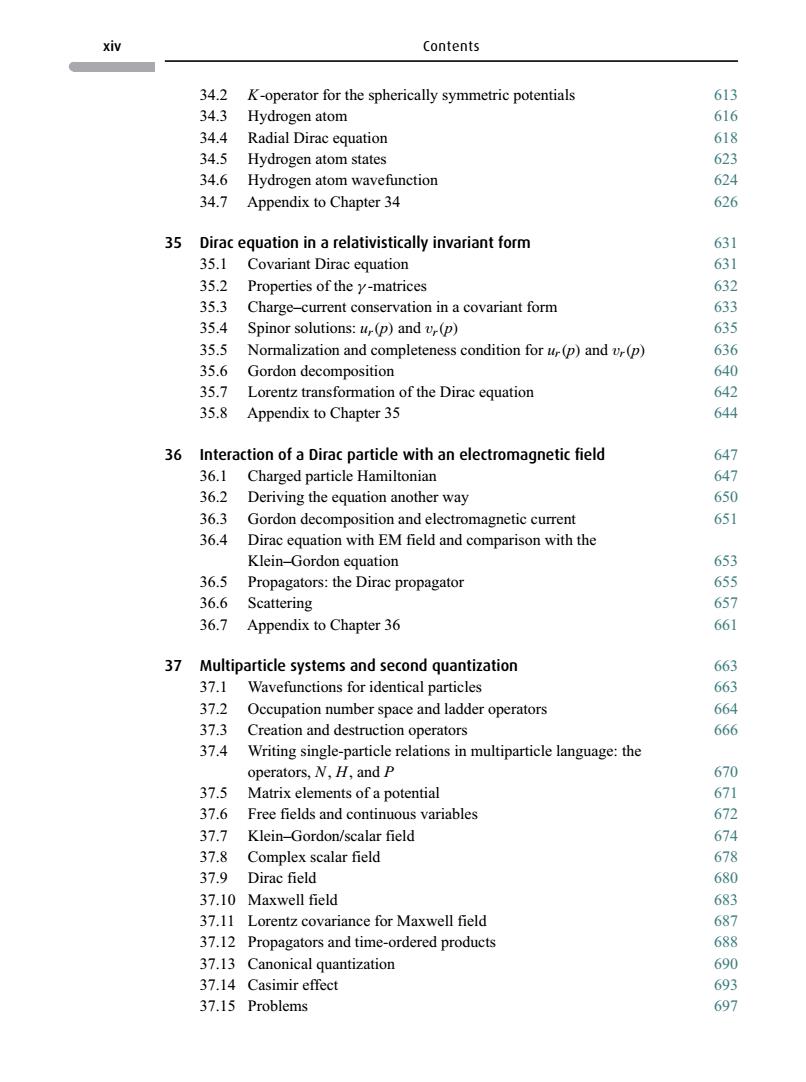
XIV Contents 34.2 K-operator for the spherically symmetric potentials 613 34.3 Hydrogen atom 616 34.4 Radial Dirac equation 618 34.5 Hydrogen atom states 623 34.6 Hydrogen atom wavefunction 624 34.7 Appendix to Chapter 34 626 35 Dirac equation in a relativistically invariant form 631 35.1 Covariant Dirac equation 631 35.2 Properties of the y-matrices 632 35.3 Charge-current conservation in a covariant form 633 35.4 Spinor solutions:ur(p)and v(p) 635 35.5 Normalization and completeness condition for ur(p)and vr(p) 636 35.6 Gordon decomposition 640 35.7 Lorentz transformation of the Dirac equation 642 35.8 Appendix to Chapter 35 644 36 Interaction of a Dirac particle with an electromagnetic field 647 36.1 Charged particle Hamiltonian 647 36.2 Deriving the equation another way 650 36.3 Gordon decomposition and electromagnetic current 651 36.4 Dirac equation with EM field and comparison with the Klein-Gordon equation 653 36.5 Propagators:the Dirac propagator 655 36.6 Scattering 657 36.7 Appendix to Chapter 36 661 37 Multiparticle systems and second quantization 663 37.1 Wavefunctions for identical particles 663 37.2 Occupation number space and ladder operators 664 37.3 Creation and destruction operators 666 37.4 Writing single-particle relations in multiparticle language:the operators,N,H,and P 670 37.5 Matrix elements of a potential 671 37.6 Free fields and continuous variables 672 37.7 Klein-Gordon/scalar field 674 37.8 Complex scalar field 678 37.9 Dirac field 680 37.10 Maxwell field 683 37.11 Lorentz covariance for Maxwell field 687 37.12 Propagators and time-ordered products 688 37.13 Canonical quantization 690 37.14 Casimir effect 693 37.15 Problems 697
xiv Contents 34.2 K-operator for the spherically symmetric potentials 613 34.3 Hydrogen atom 616 34.4 Radial Dirac equation 618 34.5 Hydrogen atom states 623 34.6 Hydrogen atom wavefunction 624 34.7 Appendix to Chapter 34 626 35 Dirac equation in a relativistically invariant form 631 35.1 Covariant Dirac equation 631 35.2 Properties of the γ -matrices 632 35.3 Charge–current conservation in a covariant form 633 35.4 Spinor solutions: ur(p) and vr(p) 635 35.5 Normalization and completeness condition for ur(p) and vr(p) 636 35.6 Gordon decomposition 640 35.7 Lorentz transformation of the Dirac equation 642 35.8 Appendix to Chapter 35 644 36 Interaction of a Dirac particle with an electromagnetic field 647 36.1 Charged particle Hamiltonian 647 36.2 Deriving the equation another way 650 36.3 Gordon decomposition and electromagnetic current 651 36.4 Dirac equation with EM field and comparison with the Klein–Gordon equation 653 36.5 Propagators: the Dirac propagator 655 36.6 Scattering 657 36.7 Appendix to Chapter 36 661 37 Multiparticle systems and second quantization 663 37.1 Wavefunctions for identical particles 663 37.2 Occupation number space and ladder operators 664 37.3 Creation and destruction operators 666 37.4 Writing single-particle relations in multiparticle language: the operators, N, H, and P 670 37.5 Matrix elements of a potential 671 37.6 Free fields and continuous variables 672 37.7 Klein–Gordon/scalar field 674 37.8 Complex scalar field 678 37.9 Dirac field 680 37.10 Maxwell field 683 37.11 Lorentz covariance for Maxwell field 687 37.12 Propagators and time-ordered products 688 37.13 Canonical quantization 690 37.14 Casimir effect 693 37.15 Problems 697